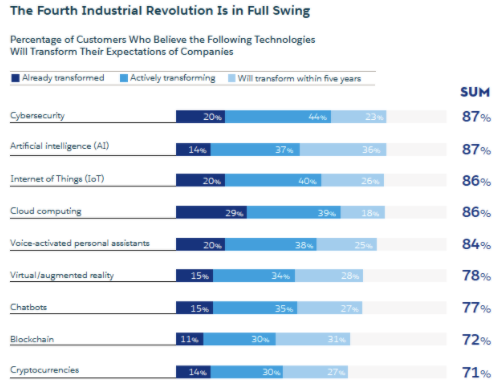How are today's technologies and current trends shaping and changing the world we live in, and how is it impacting today's businesses?
In this week’s Knowledge Nuggets, we’re covering The Fourth Industrial Revolution by Klaus Schwab, chairman of the World Economic Forum.

Insight: Organisations that are focused on innovation and explore new ideas and business models will stand out as the winner in today’s digital age.
Data: 43.9% of Australian employment is highly susceptible to being automated. (Industry.Gov)
What’s the step change: Focus on developing the key capabilities that make us human and indispensable. Download The Fourth Industrial Revolution book summary to learn more.
So what is the fourth industrial revolution anyway and why does it matter?
In The Fourth Industrial Revolution, Klaus Schwab talks about the opportunity to shape how we live and work through what he calls the fourth industrial revolution.
We all coursed through the mechanical stage through to the electrical stage that enabled mass production. On the third revolution, we saw the advent of computers and the rise of information technology and automation. The fourth is what Schwab calls Synthesis revolution where cyber, physical, and medical biotechnologies come together.

According to Klaus Schwab, the fourth industrial revolution is more significant, and its ramifications are more profound than any prior period of human history. He outlines the key technologies driving this revolution and discusses the major impact expected on government, business, civil society, and individuals.
So let’s go a little deeper and look into what matters with those technologies.
The fourth revolution is a cyber and physical integration piece — with the physical referring to autonomous vehicles, 3D printing, advanced robotics, and super materials. This has brought on seismic shifts in the way we produce things and how this is being used across society.

These are the top 4 that we need to watch out for.
1. Digital Tech
This refers to the Internet of Things, Blockchain, platform revolutions, and scalability. We did a separate piece on platform revolution but these refer to scalable technologies where their relative cost of production tends towards zero and winner takes all. So we’re going to see things like blockchain technology controlling a register, voting, or tax.
2. Medical Genetics
This will be the most transformational. This includes things like the human genome being coded and the cost dropping from billions to probably a single dollar soon. DNA editing, bio printing — it raises all these ethical questions with designer babies becoming the real issue that we’re grappling with on the emerging horizon.
So this is what the Fourth Industrial revolution is all about. And then it hints to how these technologies come together. Klaus Schwab runs a set of crowd exercises based on his connections and does some research on the probability of certain events happening by 2025.
This is a list that you need to have a look at to see what’s going to change, depending on your business. It’s asks a series of important questions: whether or not we’re going to have phones implanted, when there’ll be a million sensors connected to the internet of things, when there’ll be cities with no traffic lights, and how autonomous vehicles change the way we move and operate in society. In this section, Klaus Schwab places some predictions, bets, and probabilities on that front.
For more on this, download the Knowledge Nugget: The Fourth Industrial Revolution PDF
3. Probability
This is an index done by the Oxford Martinne Program on Technology and Employment and covers the probability that your sector, industry, and profession will exist no more and will be replaced by automation.
Studies show that the first top 3 professions to go are telemarketers, tax preparers, and insurance appraisers. The least likely to go according to the study are social workers, choreographers, and surgeons. (Plumbers should also get an honourable mention in there.)
The point is, no matter your profession, at some point the probability of use being replaced by cyborgs is high and we need to double down on the value we bring as humans, which makes for an interesting capabilities conversation.
4. Digital Clones
The fourth one (which is mind-blowing) is the conversation centred on digital clones. Here, the conversation starts off with large factories that have an interplay of real turbines and digital, computer-based models. These digital turbines spin along real ones and have sensors feeding off information from the real turbines into the model or the clone to trigger servicing and wear out. Data from the computer-based turbine model and the real turbines are integrated and collated with all essential factors put together to improve performance.
The interesting question here is, as humans, what happens when we have our own digital clones that match our capabilities and our data?
So that’s the premise of The Fourth Revolution.
Have a look at how these things will come together and affect you.
Download our Knowledge Nugget on The Fourth Industrial Revolution:
















